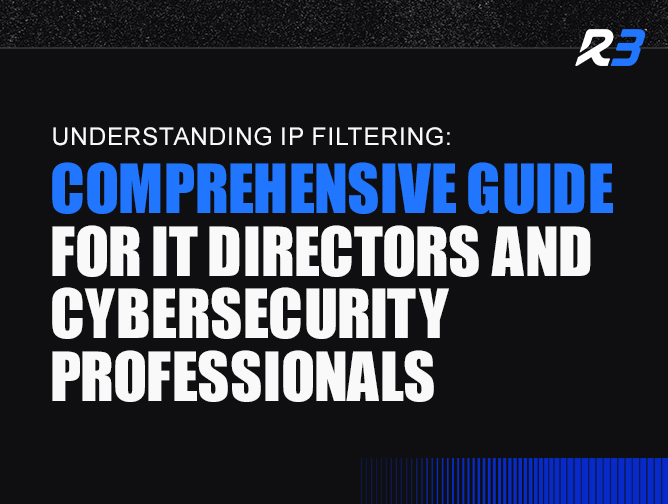Understanding IP Filtering: Comprehensive Guide for IT Directors and Cybersecurity Professionals

As cybersecurity threats continue to evolve at a rapid pace, safeguarding digital assets has become the cornerstone of enterprise network security. Within this realm, IP filtering emerges as an essential mechanism—simple in concept yet profound in impact. We invite IT directors and cybersecurity professionals to engage in an in-depth exploration of IP filtering, unraveling its technicalities and practical applications.
What is IP Filtering?
IP filtering is the process of granting or denying data packets based on their IP address. At its core, this technique is pivotal for controlling access to a network environment, defining who can engage with your network infrastructure and who should be kept at bay.
Fundamental Concepts:
- IP Addresses: The cornerstone of digital networking, identifying devices within a network.
- Subnetting: The act of subdividing networks for improved management and security.
- Classless Inter-Domain Routing (CIDR): A method for allocating IP addresses and IP routing, supplanting the older system with a more flexible addressing strategy.
Types of IP Filtering
Stateful Filtering
Referring to the capacity of the firewall to monitor active connections and determine whether packets are part of an established session, stateful filtering employs a dynamic approach to network security.
Stateless Filtering
In contrast, stateless filtering operates without context, examining packets in isolation against predefined rules, regardless of connection state.
A thorough comparison underscores the strategic capacities of each approach, influencing deployment choices.
The Risks Without IP Filtering
Without the implementation of IP filtering, networks become vulnerable to a variety of security threats. Unfiltered access can expose an organization to cyber-attacks such as:
Unrestricted Access & Breaches
Allowing all traffic through can lead to unauthorized access to sensitive data, increasing the risk of data breaches and intellectual property theft.
Denial of Service (DoS) Attacks
Unregulated IP access makes it easier for malicious actors to inundate a network with traffic, overwhelming systems and resulting in service disruptions.
Network Scanning
Hackers can freely scan a network for open ports and vulnerabilities, which can be exploited to gain access or disrupt services.
Malware Infection
The risk of malware entering the network is significantly higher without IP filtering, as it can be introduced through any unvetted data packet.
IP filtering acts as a first line of defense, reducing these risks by ensuring that only legitimate traffic enters the network. It plays a critical preventative role by:
- Verifying the source of incoming packets to prevent unauthorized network access.
- Thwarting intruders and safeguarding against various forms of cyber-attacks.
- Reducing the attack surface by limiting the number of entry points to the network.
- Preventing reconnaissance activities that could lead to more sophisticated attacks.
Advanced Techniques in IP Filtering
Beyond foundational mechanisms, several advanced techniques refine IP filtering’s functionality:
- Access Control Lists (ACLs): Directives dictating the traffic flow between network devices.
- Port-Based Filtering: Control measures based on TCP/UDP ports to protect specific services.
- Protocol-Based Filtering: Rules targeting specific protocols to fine-tune network traffic.
- Dynamic Filtering: Techniques adaptive to ongoing network activities that provide an additional layer of security.
Real-World Applications of IP Filtering
Illustrating IP filtering’s practicality, we delve into real-world applications:
Securing Networks
A significant case study involves a multinational corporation with distributed operations across continents. By deploying IP filtering tactics, it could isolate sensitive customer data and internal communications, creating a segmented network infrastructure. This led to the development of tailored access policies which drastically lowered the frequency and severity of unauthorized access incidents and data breaches. IP filtering became a pivotal part of the company’s defense-in-depth strategy, demonstrating its effectiveness in a complex, globalized business environment.
Combatting Attacks
An e-commerce platform faced a surge in credential stuffing attacks, where automated bots attempted to access user accounts through stolen login data. To address this, the company implemented IP filtering to identify and block IP addresses that repeatedly made unsuccessful login attempts. This approach effectively cut down the rate of account compromises. Simultaneously, it was crucial to fine-tune IP filtering thresholds to avoid hampering the experience of legitimate users, hence maintaining the delicate balance between robust security and user convenience.
Regulatory Compliance
In the healthcare sector, the use of IP filtering goes beyond conventional security measures, playing a vital role in compliance with regulations like the Health Insurance Portability and Accountability Act (HIPAA). By restricting access to patient records and other sensitive information through IP filtering, healthcare providers can enforce strict data privacy. The implications of this go beyond mere compliance; it fosters trust with patients, ensuring that their personal information is secured against unauthorized viewing, thus reinforcing the providers’ reputation for confidentiality and reliability in handling patient data.
Best Practices for IP Filtering Configuration
Implementing IP filtering successfully requires adherence to industry best practices:
Effective Rule Setting
In the realm of Effective Rule Setting, the crux lies in creating specific, purpose-driven rules that both prevent unauthorized access and allow legitimate traffic to pass unimpeded. This precision targeting is achieved through a deep understanding of network traffic patterns and the deployment of granular rules that align with organizational objectives. For instance, establishing a default-deny stance where only explicitly permitted IP addresses can access certain resources can drastically reduce the attack surface. Best practices dictate that rules should be regularly reviewed and pruned to eliminate any that are obsolete or redundant, thereby optimizing the performance of the filtering system and minimizing potential security loopholes.
Monitoring and Updates
Monitoring and Updates are critical components that inform the effectiveness of IP filtering over time. Continuous monitoring of network activity serves as an early warning system to detect unusual patterns suggestive of cybersecurity threats. IT professionals must employ tools that facilitate real-time alerting and comprehensive logging. These logs can then be analyzed to identify trends and adapt IP filtering rules as necessary. Moreover, staying abreast of threat intelligence reports enables proactive updates to filtering criteria to counter emerging threats. This dynamic approach ensures that IP filtering remains a stalwart defender against intrusion attempts.
Integrative Security
Lastly, the concept of Integrative Security highlights the notion that IP filtering should not stand in isolation but rather function as a facet of a multi-layered security strategy. Integration with other security mechanisms such as intrusion detection systems (IDS), intrusion prevention systems (IPS), and advanced threat protection platforms can create a symbiotic environment that increases overall security efficacy. For example, an IDS coupled with IP filtering can analyze patterns to identify attacks, after which the IP filtering rules can be adjusted to block malicious traffic based on those findings. This collaborative approach to network defense ensures that IP filtering is not a standalone barrier but a coordinated effort in a larger security fabric.
What does it all mean?
As we wrap up this guide, the salient role of IP filtering in safeguarding network security is evident. The technical insights furnished pave the way for IT directors and cybersecurity professionals to harness robust IP filtering measures. In a digital landscape fraught with vulnerabilities, proactivity in network security protocols is not optional—it is imperative. It is also important to note that IP filtering is just one of many levels required to develop a secure network.
It is time to evaluate and augment your network defenses. Employ the sophisticated asset of IP filtering, and fortify the bulwarks that protect the lifeblood of your digital ecosystem. Your proactive measures today will chart the course of your enterprise’s security tomorrow.





